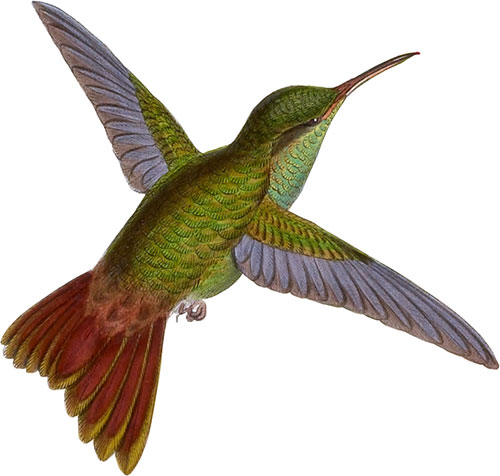In order to effect a correct determination of many species of this group of birds, I have found it absolutely necessary to examine the typical specimens from which the original descriptions were taken,—a task of no ordinary difficulty, distributed as they are among our own and the Continental museums, both public and private.
With regard to those described by M. Bourcier, I have had but little trouble, since they have not only been freely submitted to my inspection in his own cabinet, but they have, in many instances, been transmitted for this purpose to my own house; and his kindness has been especially serviceable with regard to the bird here represented (Amazilia Devillei), as there are two or three species of this form so nearly allied to each other that one description would almost serve for all, particularly if the minute points of difference are not included therein. Thus, by description alone, it would be very difficult to distinguish the Amazilia Deville from the A. Arsinoë; yet these birds are really quite distinct—one (the Arsinoë) inhabiting Mexico, and the other (the Devillei) Guatemala. In size, too, they are very much alike; but the tail of Devillei is by far the deepest and richest in colour, and has the beautiful fiery violet tints predominating over the other red parts of the feathers, while the contrary is the case in Arsinoë. The wing in Devillei, also, is much darker than in drsinoé, the base only of the primaries and secondaries being rufous chestnut, while in Arsinoé somewhat more than the basal half is of this colour; and, finally, the green of the under surface is much deeper, and extends further down towards the tail-coverts than in Devillei.
As I have before mentioned, the native country of the A. Devillei is Guatemala. Some of the specimens I possess were transmitted to me by Mr. Skinner, while others were received from Mr. Salvin, who collected them at Dueñas. Although I have said that the Arsinoë inhabits Mexico, and the Devillei Guatemala, I do not believe that the two birds are strictly confined to those respective countries, but that they will pass the border-line at one or other season of the year. I believe that the note attached by Mr. Salvin to Arsinoë has reference to this bird, and not to that species; if so, I fear I may have inadvertently led him into the error by giving a wrong name when he submitted his collections to me on his return from Guatemala.
It would be difficult to define in writing the minute differences which exist in the external appearance of the sexes, the colouring being so very similar. In size, the female is somewhat smaller than her mate.
Head, wing-coverts, and back dark green; wings dark purplish brown, with a mark of rufous at the base of the primaries and secondaries; tail-coverts dark purple; tail rich fiery purple; all the under surface shining grass-green; thighs thickly clothed with white feathers; under tail-coverts pale bronzy brown; under surface of the tail purplish brown, margined and tipped with fiery copper; bill black, except the base of the under mandible, which appears to have been fleshy red; feet dark brown.
The figures in the accompanying Plate represent two males and a female, of the size of life. The plant is the Epidendrum linearifolium.
 Amazilia corallirostris
Coral-billed Amazili
Amazilia corallirostris
Coral-billed Amazili
 Amazilia Yucatanensis
Yucatan Amazili
Amazilia Yucatanensis
Yucatan Amazili
 Amazilia cerviniventris
Fawn-breasted Amazili
Amazilia cerviniventris
Fawn-breasted Amazili
 Amazilia castaneiventris
Chestnut-bellied Amazili
Amazilia castaneiventris
Chestnut-bellied Amazili
 Amazilia Riefferia
Rieffer’s Amazili
Amazilia Riefferia
Rieffer’s Amazili
 Amazilia beryllina
Berylline Amazili
Amazilia beryllina
Berylline Amazili
 Amazilia viridigaster
Green-bellied Amazili
Amazilia viridigaster
Green-bellied Amazili
 Amazilia cyanura
Blue-tailed Amazili
Amazilia cyanura
Blue-tailed Amazili
Featuring all 422 illustrated species from John Gould’s A Monograph of the Trochilidæ, or Family of Humming-Birds arranged by color.